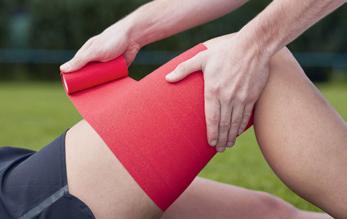
6 minute read
4.2 Energy and climate protection
energy efficiency
HARTMANN sees increasing its energy efficiency as part of its corporate responsibility and as a valuable contribution to climate protection. As a corporate group, HARTMANN uses primary and secondary energy, with electricity the dominant energy source. In terms of energy consumption, the production and logistics sites are especially relevant in this respect. Textile processes in particular, such as the yarn production and bleaching or drying goods, are energy-intensive. This also applies to the operation of clean rooms, with their associated ventilation and air-conditioning processes. Environmentally friendly and energy-efficient site operation is one of the core levers for reducing environmental impacts and the associated costs.
Advertisement
energy management
Regarding energy management at its sites, HARTMANN particularly emphasizes reducing direct and indirect fossil fuel consumption. Depending on the site, the country organizations and subsidiaries manage their energy consumption with Environmental or dedicated Energy Management Systems. In the reporting period, HARTMANN implemented the EnergieManagerPRO energy-data collection system at selected sites.
To operate its production and logistics sites, HARTMANN uses an energy mix that is both economical and environmentally friendly. At its headquarters, HARTMANN sourced electricity from the municipal utility grid during the reporting period; here, renewable energy accounted for approximately 60% of the energy mix. To promote the generation of its own electricity, HARTMANN has equipped selected pilot sites in Switzerland and India with photovoltaic systems. Going forward, the Company will examine the use of solar energy generated by photovoltaic or solar thermal systems in all new buildings. HARTMANN also strives for continuous improvement at its sites through energy efficiency measures that include switching over textile production to a more energysaving weaving method and the efficient groundwater-based cooling of its new headquarters building in Heidenheim, Germany.
HARTMANN SpAiN: HARTMANN for Future
In 2020 HARTMANN Spain launched the HARTMANN for Future project, building on previous sustainability efforts. The project aims to reduce the negative impact of business activities on the environment. To achieve this, the country organization is developing measures in the areas of energy consumption, waste, Product Lifecycle Management, transportation, and emissions. Similarly, it plans to strengthen activities to increase products’ environmental sustainability, operate buildings more efficiently, and intensify communication on its sustainability performance. HARTMANN Spain published its first Sustainability Report back in 2012, with annual editions published since 2020.
Greenhouse gas emissions
Direct and indirect emissions caused by energy consumption contribute to climate change. Greenhouse gas emissions are also generated in the upstream and downstream value chain. To counter this, HARTMANN is developing a roadmap to achieve carbon neutrality (Scope 1 and Scope 2).
To produce this, HARTMANN converted the consumption data collected across the Group using emission factors and carried out an emissions footprint analysis (Scope 1 and Scope 2) for the 2018 to 2021 financial years. With a large number of administration, manufacturing, and warehousing facilities, the Group has a highly fragmented consumer structure. HARTMANN collected relevant data from the country organizations and subsidiaries, verified their plausibility, and consolidated them at Group level.
Total greenhouse gas emissions are calculated in accordance with the internationally recognized Greenhouse Gas (GHG) Protocol Standard, with HARTMANN taking both direct and indirect emissions into account. Direct emissions are generated by sources that the Company either owns or controls; these include combustion processes at stationary plants as well as in distribution, transportation, and logistics processes using the Company’s own and leased vehicles (Scope 1). Indirect emissions are produced through using secondary energy sources such as purchased electricity and district heating (Scope 2). If available, HARTMANN calculates greenhouse gas emissions from the purchase of electricity using either supplier-specific emission factors or the emission factors of the respective national electricity mix.
carbon neutrality
In the reporting period the Company began to develop a CO2 Roadmap to achieve the Group-wide objective of climate neutrality and address site-related targets. HARTMANN sees energy efficiency and the switch to renewable energies as the major levers in reducing its own CO2 emissions, with the Company’s own energy production also having a limited impact. HARTMANN considers offsetting emissions to be a secondary solution.
Beyond its own business activities (Scope 3), the use of raw materials in the upstream and downstream value chain has a particular influence on overall emissions. In the years to come, HARTMANN therefore plans to develop a roadmap to reduce corresponding Scope 3 emissions.
KoB: eco-friendly coating

KOB evaluates the environmental impact of products, technologies, and processes before introducing them. The goal is to save resources such as energy and water through environmentally friendly processes and technologies. In 2020 the company put a new cooling system for the coating process into operation at the main production plant in Wolfstein, Germany. This ensures that medical textiles are produced in a more sustainable way and helps reduce climate-damaging greenhouse gas emissions. Thanks to this system, energy consumption was reduced by 8% and solvent use by 40%. In addition, the company has replaced conventional refrigerant with a natural, significantly lower-emissions product and also cut the amount used
03 | ENERGY USE AND GENERATION in MWh1
2018 2019 2020 2021
Total energy use
Direct energy use Of which natural gas Of which diesel2 287,961 304,203 282,643 290,696
112,237 119,546 109,168 111,159 96,360 103,567 99,074 102,358 15,877 15,979 10,094 8,801
Indirect energy use Of which electricity Of which district heating 175,558 184,499 173,338 179,391 165,881 174,432 162.075 165,424 9,677 10,067 11,263 13,967
Own energy generation 166.2 158.2 136.5 145.3
1 Deviations between individual positions and the total sum are due to rounding. 2 Only includes consumption at Paul Hartmann AG.
04 | GHG EMISSIONS in t CO2e1, 5
2018 2019 2020 20212
Total GHG emissions 71,581 73,148 61,392 62,023
Total Scope 1 emissions Of which direct energy consumption in production Of which direct energy consumption by the HARTMANN vehicle fleet3
Total Scope 2 emissions Of which electricity Of which district heating 24,077 25,760 23,253 23,859 19,901 21,557 20,524 21,479
4,176 4,203 2,729 4 2,380
47,504 47,389 38,138 38,164 45,203 44,654 35,236 34,568 2,301 2,735 2,902 3,596
1 Deviations between individual positions and the total sum are due to rounding. 2 Where no current (2021) emissions factors were presented, 2020 emissions factors were used. This applies particularly to smaller locations. 3 Only includes consumption at Paul Hartmann AG. 4 Extrapolated data were used in some cases (2020: August to October). 5 The coverage of the CO2 analysis for Scope 1 and Scope 2 is 99% for the energy types gas, electricity and district heating.
The analysis does not include the CO2 emissions of smaller locations or vehicle fleets at international companies.
Kneipp has implemented numerous measures contributing to sustainable production in recent years. Since 2010 the company has used hydroelectric power and feeds a large amount of heat from production into the heating system. Further, Kneipp harnesses waste heat from compressors to preheat process water. The focus is also on sustainability when it comes to products – from the purchase of raw materials, through production and packaging, to logistics. By 2025 the company plans to phase out plastics in packaging and to use a bio-based material instead. Kneipp calculates both the company’s and its products’ emissions footprint, and works continually to reduce emissions. This HARTMANN subsidiary offsets unavoidable Scope 1 and Scope 2 emissions with certified climate protection projects. Kneipp has been climate-neutral since the end of 2020. In the current year, the company is taking the next step to make its entire product portfolio CO2 neutral.


HARTMANN GB: emissions and energy consumption reduced
To cut CO2 emissions, HARTMANN GB in the United Kingdom is successively converting its company fleet to low-emissions vehicles, with 93% of all vehicles newly leased in 2021 either hybrid or electric. Although only 3% of the entire fleet had environmentally friendly fuel systems in 2018, 43% of the fleet is now equipped with them.
In addition, HARTMANN GB is intensifying its work on more energy-efficient site operation. Towards this goal, in 2019 the company installed energy-saving smart lighting and thereby reduced energy consumption by 15%.










